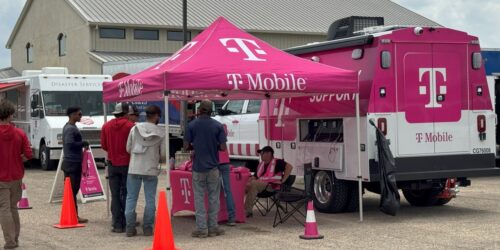It’s hard not to notice how much attention 5G has been getting lately. It’s been the lead story on the evening news, the top story on major news sites, and the subject of a lot of discussion recently. Unfortunately, a lot of it has been confusing to those outside the wireless industry, in large part because of concerns raised by the FAA (Federal Aviation Administration) and the aviation community.
What’s really going on is that two of the big three US telco operators just turned on the usage of some important new mid-band frequencies for 5G called C-Band that promised to finally bring them into the modern era. In the meantime, T-Mobile has been using a different set of mid-band frequencies (which they acquired via their merger with Sprint two years ago) to continue building out a speedy 5G network of their own. (As numerous recent comparative speed tests from companies like Ookla and OpenSignal have shown, that strategy has been working quite well for T-Mobile—but we’ll get into the details a bit later.)
To really make sense of all this, you have to understand a few basic principles about how cellular networks work. All wireless networks use radio waves at different frequencies to send and receive signals. To avoid interference with one another—as well as with other devices—companies acquire the exclusive rights to use different frequencies from the FCC, who oversees and manages that process for the US.
With previous cellular networks, like 3G and 4G, all the frequencies were in a limited range from about 600 MHz to 1.9 GHz (think of it like different stations on a radio dial). One of the unique characteristics of 5G is that it opened up the possibility to use different ranges of frequencies to help enable faster speeds and more capabilities. Low-band frequencies, below 1 GHz, were turned on for 5G by all three major US carriers when the service first became available, the experience, though faster than 4G for download speeds, was not noticeably different for most people. The high band, mmWave frequencies (28 GHz), were also turned on for 5G use a few years back. These frequencies offer the potential for very fast speeds, but only travel very short distances and are blocked by things like windows, walls, trees or even people. As a result, they’re really only useful for specialized environments like stadiums, and too expensive to be widely used for general purpose networks.
Mid-band frequencies (typically from about 2.5 to just under 6 GHz), on the other hand, have the right combination of both speed and coverage to make them an ideal fit for broad, fast 5G networks. In fact, virtually every 5G network around the world is based exclusively on these mid-band frequencies. T-Mobile’s executive leadership was aware of these possibilities, and the combination of T-Mobile’s low-band and mmWave spectrum with Sprint’s critical mid-band frequencies is what drove T-Mobile’s merger with Sprint. The result was that T-Mobile got a big, two-year head start on planning and building a modern, mid-band-based 5G network here in the US. It’s a lead that the company continues to enjoy today.
The other carriers placed early bets on mmWave, and when they pivoted to focus on mid-band spectrum much later than T-Mobile did, they had to wait until the FCC made critical mid-band frequencies available for cellular network usage. Previously, these airwaves had been used for applications like large satellite TV dishes and Department of Defense purposes. Interest in licensing those essential mid-band frequencies, also called C-Band (3.7-3.98 GHz), was so high that collectively over $80 billion – an FCC record – was spent to access them in a major auction that closed last year. In addition, just this past week, the final details of another radio spectrum auction that netted an additional $22 billion was announced (Auction 110 for frequencies from 3.45-3.55 GHz). Collectively, these two auctions finally give US carriers access to the critical mid-band RF spectrum they need to build world-class 5G networks.
For AT&T and Verizon, these frequencies allowed them to start the process of building and turning on their mid-band 5G networks, hence the recent coverage. For T-Mobile, on the other hand, these new frequencies are simply additions to their large, existing mid-band 5G networks using the 2.5-2.6 GHz frequency bands. To put it numerically, AT&T turned on 40 MHz worth of C-band 5G spectrum in eight cities, Verizon turned on 60 MHz of C-band spectrum in 46 markets, but T-Mobile has been running roughly 80MHzof its 2.5 GHz spectrum across the majority of its nationwide mid-band footprint. That’s why the previously mentioned speed tests are showing a big lead on download performance for T-Mobile.
Understanding the basics of these frequency discussions also helps put the purported airline safety issues in context. Devices in planes (and helicopters) called radio altimeters have been using frequencies in the 4.2-4.4 GHz range for decades. Even though the gap between the first C-band frequencies at 3.7 GHz and 4.2 GHz is enormous from a radio signal perspective, some concerns were raised that interference could occur. Because T-Mobile has been using 2.5 GHz frequencies for its mid-band 5G, its network is not even part of the conversation—the gap between it and what radio altimeters use is even larger.
Looking ahead, all the US carriers are expected to increase the amount of spectrum that they use for 5G services across low-band, mid-band and high-band frequencies. This provides the promise of even faster 5G networks down the road. In T-Mobile’s case, the company purchased a small bit of C-Band spectrum that it can start to use in 2023 and in the recent 3.45 GHz auction, the company added about 20 MHz in most markets to help them add on to what they already have.
Of course, there’s more to building a network than just having licenses to the spectrum. You have to build and equip cell towers all over the country with the right types of antennas and other equipment to send and receive these frequencies.
All told, we have finally entered an extremely exciting new era for 5G—one that finally starts to deliver on the promises we first heard many years ago.
Achieving that goal, however, is not a short process and there are important steps have to be taken to get there. There’s no doubt that the next few years will see some exciting developments in building out these new 5G networks, but it’s equally clear that not all the carriers are starting from the same position.
Bob O’Donnell is the president and chief analyst of TECHnalysis Research, LLC a market research firm that provides strategic consulting and market research services to the technology industry and professional financial community. You can follow him on Twitter @bobodtech.




